|
present Book Reviews For Amateur & Avocational Archaeologists |
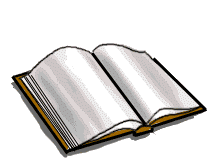 |
|
present Book Reviews For Amateur & Avocational Archaeologists |
 |
International
Archaeology
Southwest United
States
Southeast United States
Mississippian Complexes
All Other United States
Mesoamerica and South America
International (Europe, Africa,
Asia, Caribbean)
Back to Main Book Review Index
|
| Home | Gallery | Latest Finds | Back to Main Book Review Index |
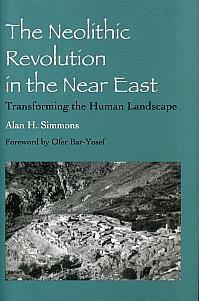 |
The Neolithic
Revolution in the Near East
Simmons’ book is the result of
over thirty years of fieldwork in the Levant, located in the
Northeastern
section of the Arabian Peninsula bordering the Mediterranean and also
called
the Near East (both vague areas geographically). The author spends a
lot of
time pointing out how complex the terminology of research of the
Neolithic has
become: i.e., there is much argument as to how many geographic variants
there
are for the Pre-Pottery Neolithic A (PPNA) period. But the chronology
of this
era seems clear: 10,500/10,200 BP to 9600/9200 BP, based on at least 70
good
radiocarbon dates. The author carefully presents us
with the history of excavation and research in the area. Simmons
clearly takes
the time to contrast prevailing ideas and lets the reader weigh the
evidence.
This makes his discussions particularly interesting. I found his
discussion of
the development of ritual behaviors in the PPNA very thought provoking,
concluding that, in his opinion, at this early stage, “there was no
sharp
distinction between the sacred and secular worlds.” His discussions of
megasites, what they are and what happened to them, was also a good
read. I also really enjoyed Simmons’
integration of
case studies throughout the book. If you are curious about this region
and at
all interested in the critical theories of early civilization, then you
will
appreciate the broad selection and even-handed method in which Simmons
presents
them. Simmons is seeking answers to some of archaeology’s biggest
questions. Research in the Near East
continues to show the considerable influence of early civilizations in
this
area—here is where humans first experimented with civilization! I highly recommend this book. The Neolithic Revolution in the Near East is available directly from the publisher’s website, for $55.00 (cloth hardback), by clicking here. reviewed
by Bob
Wishoff
|
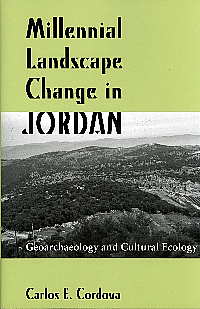 |
Millennial
Landscape Change in Jordan: Cultural
ecology is the study of
the relationship
between a given society and its natural environment(first articulated
by Julian
Steward in a breath-taking volume entitled Theory of Culture Change in
1955) -
The central argument is that the natural environment, in small scale or
subsistence societies dependent in part upon it - is a major
contributor to
social organisation and other human institutions, particularly those
concerned
with the distribution of wealth and power in a society. Geoarchaeologists
study
the natural physical processes that affect archaeological sites such as
geomorphology, the formation of sites through geological processes and
the
effects on buried sites and artifacts post-deposition.
Geoarchaeologists' work
frequently involves studying soil and sediments as well as other
geographical
concepts to contribute an archaeological study. With these
definitions in mind, it is easier to understand
the general scope of this volume, as well as its implications. Author
Cordova
has written a book which is a righteous read even if, you, the reader,
are not
the least bit interested in the archaeology of this particularly
important
region. It is absolutely necessary to understand the geological and ecological scenarios of a society in order to put into perspective the reasons for a society’s rise and fall. Studying artifacts alone could never tell you why certain resources were exploited and how they were managed, details certainly extremely important in the larger context of a society’s existence. In places such as Jordan, environmental changes were radical, and thus created stresses which stimulated great innovation in politics, as well as landscape and resource management. Read this book if you are interested in seeing the relationships elicited through study of these important topics--- see how this kind of research not only helps understand what happened within a region, but how relationships with surrounding regions were affected by changing environmental conditions. “Cordova focuses on geoarchaeological and cultural ecological aspects of research, presenting data from physical, chemical, and biological sources. He examines the changing influence of climate, vegetation, and hunting opportunities on cultural exploitation tactics, as well as the effects of the growing populations and agriculture on the environment.” With global warming such a hot topic (pardon the pun) in our world today, it’s good to find such a book which can put into context some of the ways in which the ancient world dealt with similar life-changing trends. Another reason to study the past! Millennial Landscape Change in Jordan can be ordered directly from the publishers, for $55.00 (cloth hardback), by clicking here. reviewed
by Bob
Wishoff
|
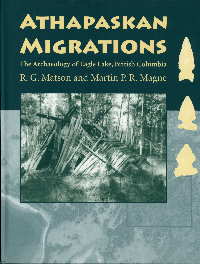 |
Athapaskan Migrations: Much is known about how migration has influenced culture throughout the North American continent, but little is known about the actual timeframes and passage. What is hinted at can be seen in linguistic affiliations between the northern Athapaskan-speaking tribes and the Southwestern Athapaskan-speaking Navahos: one example-- both describe themselves as “Dine,” which means “The People.” This would seem to indicate a migration from the North, but this is difficult to prove from within the archaeological record, i.e., from the material remains. In Athapaskan Migrations, the authors discuss 25 years of research into migrations of the Athapaskan-speaking Chilcotin Indians into interior west central British Columbia from western British Columbia. What is most significant about this book is that the authors have contrived and tested many new methods for the inference of migration from within the archaeological record. As such, the book will be of particular interest to archaeologists, cultural anthropologists, linguists and Athapaskan scholars alike. Aside from the
background chapter on the project’s history,
others cover methodology, settlement patterns, investigation of Plateau
Pithouse and British Columbian Athapaskan Traditions, ethnic
identification of
excavated materialism, the Chilcotin migration and its implications of
the
greater Pacific Athapaskan, Navaho and Apache migrations, as well as
summaries
of the excavations. Athapaskan Migrations can be
ordered direct from the
publishers for $65.00 (cloth hardbound) by clicking here. reviewed
by Bob
Wishoff
|
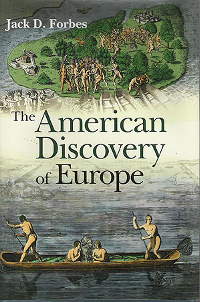 |
The American Discovery of Europe
reviewed by Charles
Swenson
|
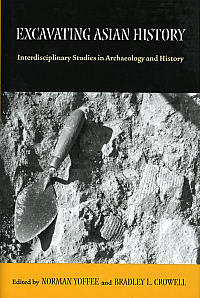 |
Old
World archaeology is distinctively different from New World archaeology
in that,
in the former, there is often a written record against which it can
compare itself. It is the written record
which is usually
best known, the literary record reaching us from the past often seeming
much
more substantial than the physical artifacts and structures which have
come
down to us over the ages. An outstanding
example of this integration of historical and archaeological fact is
Schliemann’s
excavation of Troy inspired by the Homer’s Iliad, but a number of
parallels can
be drawn with ongoing studies in China, as well as other areas of Asia. reviewed by Charles Swenson
|
| Home | Gallery | Latest Finds | Back to Main Book Review Index |